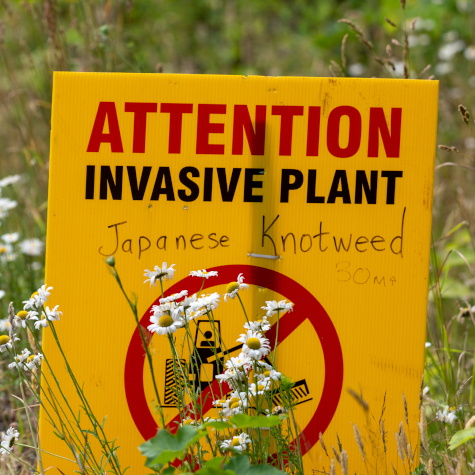
A seemingly innocuous plant introduced to Britain in the 19th century, Japanese knotweed has evolved into a formidable adversary for property owners and professionals alike. Its pervasive growth and potential for property damage have sparked a renewed surge in litigation in recent years, shaping the legal landscape around UK property disputes.
Known for its aggressive growth patterns, Japanese knotweed has become a term synonymous with severe structural damage. Despite being relatively new to the realm of property litigation, the rapid proliferation of knotweed claims in recent years underscores the need for comprehensive understanding and effective management strategies.
From the Wildlife and Countryside Act of 1981 to the Environmental Protection Act of 1990, the spread of knotweed has called for legislative milestones in an attempt to control its spread and account for its damage. Recent legal cases such as Network Rail Infrastructure Ltd v Williams & Anor (2018) have thrown knotweed back into the spotlight, establishing crucial precedents regarding knotweed’s impact on property values.
As we navigate the complexities of knotweed litigation, it becomes evident that a nuanced understanding of both the legal intricacies and practical challenges surrounding this pervasive species is essential. With careful analysis and actionable insights, this paper should equip stakeholders involved in property transactions and dispute resolution with the knowledge and strategies necessary to combat the Japanese knotweed conundrum effectively.
What is Japanese Knotweed?
Japanese knotweed, scientifically known as Reynoutria Japonica, was introduced to Britain in the 19th Century as an ornamental garden plant. It is characterised by bamboo-like stems, rapid spread and persistent growth patterns. Its formidable growth outcompetes and suppresses the growth of other vegetation, threatening native species.
During the winter months the plant recedes to ground level, only to resurge vigorously from deeply entrenched roots, reaching heights exceeding 2.1 metres by early summer. Because of these deep-set rhizomes, Japanese knotweed proves exceptionally resistant to both manual removal and chemical eradication. The only reliable way to eradicate knotweed completely is to dig up these roots, which results in a great deal of disturbance for property owners, and high volumes of contaminated waste.
Herbicides can slow down knotweed by killing off the stems and leaves, but the roots are liable to live on, spreading rapidly underground in search of moisture. They exploit cracks, mortar joints and other weak areas in masonry, exerting upward and outward pressure, and blocking drains and pipes. As a result, walls, paved areas and underground infrastructure are all at risk of being weakened or destroyed by the plant.
Japanese Knotweed Legislation
The Wildlife and Countryside Act 1981 laid a foundation for addressing the spread of Japanese knotweed, making it a legal offence to cause its growth in the wild. Actions which cause the spread of Japanese knotweed, such as strimming or dumping contaminated garden waste, can be prosecuted in court. Allowing Japanese knotweed to spread from a contaminated property into neighbouring land can also be seen as an offence under this act.
The Environmental Protection Act 1990 propelled knotweed into the realms of property law and public awareness. Part 2A of this legislation designates knotweed as a ground contaminant, necessitating its remediation on affected properties. This transition in legal status had significant implications for property owners, affecting property values and triggering legal disputes.
In response, property surveyors began to prioritise the identification of knotweed, recognising its potential to devalue properties and disrupt transactions. Consequently, lenders became wary of financing properties affected by knotweed, exacerbating the challenges faced by owners of contaminated properties. Litigation concerning knotweed encroachment and its impact on neighbouring properties became increasingly prevalent, prompting courts to grapple with complex issues of liability and damages.
Japanese knotweed came back into the spotlight in 2013, when new government guidance was issued stating that sellers should report the plant’s presence on their property as part of conveyancing. The TA6 form now asks sellers to confirm whether their property is affected by knotweed and, if it is, to provide a management plan for professional eradication. Many mortgage lenders subsequently require a management plan to be in place before agreeing funds and allowing the purchase to be completed.
An amendment to the Anti-social Behaviour, Crime and Policing Act 2014 gave extra responsibilities to property owners for avoiding the plant’s spreading, stating that while it is not illegal to have the plant on your property, property owners need to make reasonable attempts to control it and prevent it from becoming a problem in the surrounding neighbourhood. If the spread of knotweed from a property has “detrimental effect of a persistent or continuing nature”, the owner liable to be prosecuted.
As the legal framework continues to evolve, stakeholders must remain vigilant, navigating the intricate intersection of legislation and litigation surrounding Japanese knotweed to effectively manage its impact on property values and transactions.
The Rise of Knotweed Awareness
Due to this changing legislation, Japanese knotweed has emerged as a topic of heightened awareness and concern among property owners, professionals, and the general public alike. This ongoing awareness can be attributed to the concerted efforts of property surveyors, who actively identify and document its presence during property inspections.
The Royal Institution of Chartered Surveyors (RICS) has issued guidelines and professional standards to equip its members with the knowledge and tools necessary to detect and manage knotweed infestations. By incorporating knotweed awareness into their practices, surveyors have increased the general understanding of the risks associated with this invasive plant.
However, despite efforts to raise awareness responsibly, media sensationalism has often distorted perceptions of Japanese knotweed, amplifying fears and misconceptions.
Sensationalist reports highlighting knotweed’s ability to penetrate concrete have perpetuated
exaggerated fears among the public, fueling anxiety around knotweed-infested properties.
Recent research has challenged many of these media myths. Studies conducted by organisations such as AECOM (Architecture, Engineering, Construction, Operations, and Management) and the University of Leeds have revealed that knotweed’s actual capacity to cause structural damage is often overstated, and that the plant’s underground rhizomes typically extend a few metres in the ground rather than the tens of metres often reported.
By untangling these knotweed myths and contrasting them with empirical evidence, researchers aim to restore a balanced understanding of knotweed’s true risks and mitigate unfounded fears among property owners and the general public.
The Impact on Property Value
Due to actual damage, potential for litigation and media speculation, the presence of Japanese knotweed on a property can significantly diminish its market value. Any mention of knotweed in a surveyor’s report can deter potential buyers, leading to prolonged periods on the market and reductions in selling price. Studies conducted by property valuation experts reveal that homes with knotweed infestations could sell for 10-20% less than their knotweed-free neighbours.
The presence of knotweed poses considerable challenges in property transactions, complicating negotiations and potentially derailing deals. Lenders are often hesitant to finance properties affected by knotweed, citing concerns about the long-term viability and marketability of such investments. Consequently, sellers may be forced to lower their asking prices. The costs associated with knotweed remediation efforts only add to the financial burdens faced by property owners and sellers.
Navigating the complexities of property transactions involving knotweed-affected properties requires careful consideration of the associated risks and mitigation strategies. Stakeholders must collaborate closely with legal and real estate professionals to devise effective solutions that safeguard their interests while ensuring transparency and compliance with regulatory requirements.
By addressing these challenges proactively, stakeholders can mitigate the financial impact of knotweed infestations and safeguard the integrity of property transactions.
The Knotweed Litigation Landscape
As a relatively new property litigation issue, the legal landscape around Japanese knotweed is still taking shape. Most claims in the UK are small and settled privately, meaning we have few written judgments to refer to.
However, larger-scale cases such as Network Rail Infrastructure Ltd v Williams & Anor (2018) have played a pivotal role in shaping the landscape of knotweed litigation. The case involved two owners of adjoining cottages affected by dense and long-standing knotweed infestations on a nearby railway embankment owned by Network Rail.
The court’s decision recognized knotweed encroachment as an actionable nuisance and established that the presence of knotweed can diminish property values. This ruling marked a significant milestone in knotweed litigation, setting a precedent for future cases and highlighting the legal responsibilities of property owners and entities like Network Rail in managing infestations and mitigating their adverse effects on neighbouring properties.
In the more recent case of Davies v Bridgend County Borough Council (2023), the Court of Appeal ruled that the council could be held liable for damage caused by Japanese knotweed encroaching onto neighbouring residential property. The council had argued that they couldn’t be held responsible because they were unaware of the risks posed by knotweed before 2012, which was the year given for constructive knowledge according to the Network Rail decision.
However, the court rejected this argument, establishing that knotweed claims predating 2012 could still succeed. Additionally, the court confirmed that diminution in property value due to knotweed can be claimed as part of a nuisance case. This ruling provides claimants with stronger legal grounds than ever to pursue compensation for knotweed-related damages.
Such cases have set a significant precedent for property owners, buyers and sellers when it comes to litigation around Japanese knotwork, and subsequent concerns have led to the emergence of a knotweed litigation industry, with numerous firms offering specific legal services for knotweed-related complaints.
This industry encompasses a wide range of stakeholders, including property owners, buyers, sellers, and legal professionals, all seeking redress for the damages caused by knotweed infestations. The growing prevalence of knotweed litigation underscores the need for robust legal frameworks and proactive measures to address the challenges posed by this invasive plant in property disputes.
Navigating the Knotweed Minefield
Navigating the tangled web around Japanese knotweed requires a comprehensive understanding of rapidly evolving guidelines and legislation, coupled with proactive strategies to manage risks effectively. Regularly updating knowledge about knotweed identification, treatment methods, and legal obligations can ensure compliance with industry standards.
Additionally, leveraging professional networks for expert assistance and guidance can prove invaluable in navigating knotweed-related issues. By adopting best practices and maintaining vigilance in identifying and managing knotweed infestations, property professionals can uphold professional standards, protect client interests, and navigate the legal landscape surrounding Japanese knotweed with confidence.
2022’s RICS professional standards for Japanese knotweed and residential property offers a framework for assessing risks and determining management programs, with a view to reassuring stakeholders. This standard emphasises a shift towards categorising property risks based on management options rather than potential impact, providing clearer and more actionable guidance for property surveyors and professionals.
Conclusion
Japanese knotweed has carved out a significant place for itself in the area of property management and litigation, with multifaceted challenges and opportunities facing stakeholders in this domain. Looking ahead, it is likely that the future of knotweed law and property management will continue be shaped by individual legal cases and the reports of surveyors.
In response, property professionals need to remain vigilant and informed about knotweed guidance and legislation. As the prevalence of knotweed-related disputes continues to rise, proactive measures and effective risk mitigation strategies are essential to safeguarding property values and interests.
Collaboration between property professionals, knotweed researchers, and policymakers is crucial in driving progress toward a robust legal framework to address invasive plant disputes.
This ought to be our primary aim as property professionals, helping to replace media-driven stigma and a reactive litigation industry with evidence-based solutions and interdisciplinary expertise.
Together, stakeholders can navigate the complexities of knotweed management effectively while minimising environmental impact and preserving property values. These efforts will contribute to a more resilient and sustainable approach to knotweed management, ensuring the long-term health and viability of affected properties and ecosystems.

